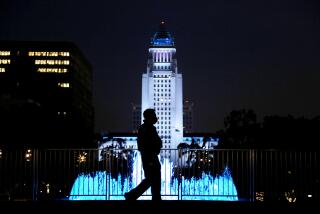REGIONAL REPORT / NERVOUS NORTHEAST : Sluggish Economy Sours Fiscal Future for Big Apple, Other Cities : Gaping budget deficits are forcing many officials to consider deep cuts in staff and services.
- Share via
NEW YORK — “Bad news can’t wait,” then-Mayor Edward I. Koch declared last year as he announced plans to hike sewer and water fees and cut services to close an unexpected $530-million gap in the city’s $27-billion budget.
Since then, however, the bad news about the Big Apple’s fiscal health has grown progressively worse.
Now, only 10 months into his term, Mayor David N. Dinkins, Koch’s successor, is facing a crisis that evokes memories of the fiscal debacle of the mid-1970s, when the city had its credit effectively shut off and it teetered on the edge of bankruptcy before being rescued by the state and federal governments.
Standard & Poor’s has already put the city’s $13 billion in general obligation bonds on “credit watch,” meaning that if New York fails to make demonstrable progress toward scaling back deficits now expected to reach as high as $1.5 billion next year, the city stands to have its credit rating lowered. That, in turn, would only burden the city with higher borrowing costs.
And throughout the city, gloom and doom are spreading as New Yorkers wonder how deep the ax will eventually cut as the city tries to bring the budget into balance. Already, the mayor has imposed a freeze on municipal hiring and wages, and is studying a plan to lay off at least 15,000 city workers to help close the widening budget gap.
He also has said that he would cut $2.3 billion from the $16-billion capital projects spending plan for the next three years, which would result in dramatic cuts in such much-needed items as park improvements, schoolhouses and street and highway repairs.
The fiscal picture in New York is similar to that in cities and states throughout the Northeast, where the spreading national economic downturn has seemed to hit harder than in any other region so far.
In Philadelphia, Mayor W. Wilson Goode has imposed a hiring freeze and delays in pension fund payments and tax refunds in efforts to erase $206 million in red ink that has threatened the city with bankruptcy. Mayors in Trenton, N.J., New Haven, Conn., and Boston, among others, are laying off workers to balance their budgets.
Connecticut, which two years ago had a “rainy-day fund” of $400 million, today has a $400-million deficit, while Massachusetts has furloughed hundreds of state employees and raised taxes and fees by more than $3 billion over the past two years to bridge an ever-widening budget gap.
“The city’s in good company,” John Petersen, research director for the Government Finance Officers Assn., said of New York. “The whole public sector is strapping down for the fiscal storm.”
In New York, experts say the fiscal situation is nowhere near as severe as it was two decades ago, when 25,000 city workers were laid off, 8,000 substitute teachers were fired and city services were slashed.
Still, there is deep concern over the ability of the Dinkins Administration to cope with the current problems. On three successive days earlier this month, for example, the mayor announced first a 5.5% pay increase for teachers, then a $1.8-billion plan to put more police officers on the streets and then the hiring and wage freeze in municipal employment.
“Each of the individual actions are defensible by themselves,” said Mitchell Moss, director of New York University’s Urban Research Center. “But they were produced in the same one-week period of time and undermine each other.”
“There are tough choices to be made, and the mayor’s going to have to figure out what his primary goals are,” added Raymond D. Horton, a Columbia University business professor and president of the Citizens Budget Commission, a nonprofit budget watchdog organization.
Even with the best of fiscal management, however, the outlook for New York and other cities in the Northeast is problematic.
“Austerity is certainly the watchword,” said Samuel Ehrenhalt, regional commissioner for the U.S. Bureau of Labor Statistics. “New York in the ‘80s was in a period of financial comeback and resurgence. There’s no question that in 1990 we’re in a period of transition to something different.”
More to Read
Sign up for Essential California
The most important California stories and recommendations in your inbox every morning.
You may occasionally receive promotional content from the Los Angeles Times.













